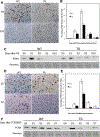Hepatocyte proliferation and hepatomegaly induced by phenobarbital and 1,4-bis [2-(3,5-dichloropyridyloxy)] benzene is suppressed in hepatocyte-targeted glypican 3 transgenic mice
- PMID: 21574168
- PMCID: PMC9990398
- DOI: 10.1002/hep.24417
Hepatocyte proliferation and hepatomegaly induced by phenobarbital and 1,4-bis [2-(3,5-dichloropyridyloxy)] benzene is suppressed in hepatocyte-targeted glypican 3 transgenic mice
Erratum in
- Hepatology. 2014 Sep;60(3):1116
Abstract
Glypican 3 (GPC3) is a family of glycosylphosphatidylinositol-anchored, cell-surface heparan sulfate proteoglycans. Loss-of-function mutations of GPC3 cause Simpson-Golabi-Behmel syndrome characterized by overgrowth of multiple organs, including liver. Our previous study showed that in GPC3 transgenic (TG) mice, hepatocyte-targeted overexpression of GPC3 suppresses hepatocyte proliferation and liver regeneration after partial hepatectomy and alters gene expression profiles and potential cell cycle-related proteins. This study investigates the role of GPC3 in hepatocyte proliferation and hepatomegaly induced by the xenobiotic mitogens phenobarbital (PB) and TCPOBOP (1, 4-bis [2-(3, 5-dichloropyridyloxy)] benzene). Wildtype (WT) and GPC3 TG mice were given 0.1% PB in drinking water for 10 days or a single dose of TCPOBOP (3 mg/kg) by oral gavage. At day 5 the WT mice showed a 2.2- and 3.0-fold increase in liver weight, whereas the GPC3 TG mice showed a 1.3- and 1.6-fold increase in liver weight after PB and TCPOBOP administration, respectively. There was a significant suppression of proliferative response in the GPC3 TG mice, as assessed by percent of Ki67-positive hepatocyte nuclei. Moreover, gene array analysis showed a panel of changes in the gene expression profile of TG mice, both before and after administration of the xenobiotic mitogens. Expression of cell cycle-related genes in the TG mice was also decreased compared to the WT mice.
Conclusion: Our results indicate that in GPC3 TG mice, hepatocyte-targeted overexpression of GPC3 plays an important role for regulation of liver size and termination of hepatocyte proliferation induced by the xenobiotic mitogens PB and TCPOBOP, comparable to the effects seen in the GPC3 TG mice during liver regeneration after partial hepatectomy.
Copyright © 2011 American Association for the Study of Liver Diseases.
Conflict of interest statement
Potential conflict of interest: Nothing to report.
Figures






References
-
- Fransson LA. Glypicans. Int J Biochem Cell Biol 2003;35:125–129. - PubMed
-
- Song HH, Filmus J. The role of glypicans in mammalian development. Biochim Biophys Acta 2002;1573:241–246. - PubMed
-
- Filmus J Glypicans in growth control and cancer. Glycobiology 2001;11:19R–23R. - PubMed
-
- Iglesias BV, Centeno G, Pascuccelli H, Ward F, Peters MG, Filmus J, et al. Expression pattern of glypican-3 (GPC3) during human embryonic and fetal development. Histol Histopathol 2008;23:1333–1340. - PubMed
Publication types
MeSH terms
Substances
Grants and funding
LinkOut - more resources
Full Text Sources
Miscellaneous
